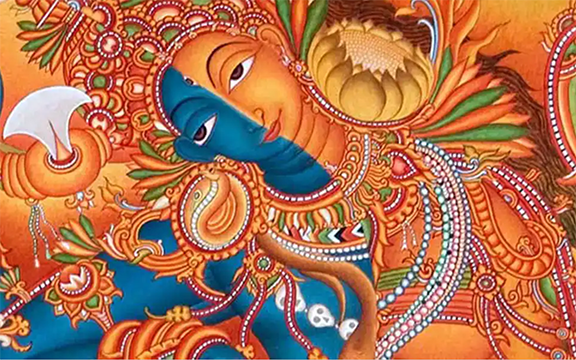
(Photo: Painting of Ardhanārīśvara, a form of Siva and Shakti as one.)
I was at an auto body shop in West Los Angeles waiting for my car, sharing the waiting area with an elderly woman who was reading Tikkun magazine. She put the magazine on a desk and I asked if I could read it while I was waiting. She said yes. I sifted through the table of contents and found an article on “Eros and Ethics,” which piqued my interest, particularly when I discovered it was mostly an article about divine union from a Kabbalistic viewpoint. Reading it I was struck by the similarities, in a general sense, with what little I knew about classical Tantra Yoga. [Note: classical Tantra Yoga has nothing to do with the modern, New Age versions of neo-tantra]
I found myself in a comparative theology course, part of a new direction in my life, which was not even a seed in my thoughts back at the body shop. When time came to write a paper I recalled that article, found it online, and this paper began its process of coming into being. As I delved deeper into the Yoga Sutras of Patanjali, as well as maintaining my connection with meditative and mystical Judaism, I began to see strong connections between the two. This was enhanced by reading literature on the connection of both systems to Quantum Mechanics. Now entering into a new phase as a student of theology, I am drawn back to these two essentially mystical/spiritual takes on the true nature of our reality.
While postmodern seekers may be most attracted to this study, the more traditional religious person should find great value in experiencing the significant role ethics and morality play in these two mystical/spiritual esoteric practices. The Tantra-Sutra says: “Yoga is undoubtedly the union (samayoga) of Shiva and Shakti.” In his book Tantra: The Path of Ecstasy, Georg Feuerstein explains the roles of the gods and goddesses who are sought out to help the practitioner through invocation, prayer ritual, meditative visualization, and mantra recitation. The deities are considered to be very real, each corresponding to a particular energetic presence that can be palpably felt in meditation, and even at other times. They are seen as personifications of specific intelligent energies present in the subtle dimension. The gods and goddesses are also seen as symbols that point beyond their immediate forms of manifestation to the absolute godhead, the singular being. The Tantras are presented as a direct communication from Lord Shiva, who declares at the conclusion of his teachings: “In reply to your questions I have completely revealed in this tantra what was the most secret discipline and the most excellent knowledge.”
In the Tantrika traditions, Ultimate Reality is known as Parama Shiva, the godhead, characterized by sat-chid-ananda—being, consciousness and bliss. Shiva, as opposed to Parama Shiva, is that aspect of the Ultimate Reality that is consciousness. It is pure consciousness, without the slightest notion of “I am.” From that perspective of evolution, the Shiva principle emerges first within Ultimate Reality and that is the transcendental “I.” It is Shiva who is the seed of the multidimensional universe, giving rise to all other ontological categories. But there is no duality in Shiva, because he is completely immersed in blissful union with Shakti.” Shakti is the principle of creativity within Ultimate Reality. She coexists with Shiva and co-creates the universe. In doing this, she triggers the process of evolution and obscures consciousness. This is seen as a veiling effect appearing to block the true nature of Shiva. However, this veiling effect does not block Shiva from our view entirely. We can get a glimpse of our true nature and are free to rediscover our essential being, just as we are free to deny it and live the inauthentic life—the life of the ordinary worldly person who follows the dictates of self-delusion, greed, and aggression as well as the other karma engendering negative emotions and attitudes.
In his book Yoga Morality, Feuerstein focuses on the role of ethics and morality in all forms of Yoga practice. “The core process of Yoga, which conducts the yogi practitioner from a state of the inauthentic existence to authentic being, is unglamorous and proceeds through the gradual, quiet transformation of one’s body and mind in everyday life. Thus, the foundation of all genuine Yoga practice, like any other spiritual discipline in the world, lies in the realm of moral behavior.” As Swami Sivananda states: “Ethics is the foundation of Yoga… as ethics is the gateway to God-realization.” This thought is supported by Mahatma Gandhi, who wrote in his autobiography of his “conviction that morality is the basis of things” and “truth is the substance of all morality.”
Feuerstein notes that the five moral disciplines of Patanjali’s classical eight-fold path constitute the ethical ground of all yogic teachings. When stripped of its spiritual and moral teachings, Yoga cannot lead to inner freedom peace and happiness as it was designed to do. He adds that the Yoga masters spoke of Jesus of Nazareth when he asked, “Who will cast the first stone?” to advise not to look at the moral flaws of others but to focus on our own shortcomings and concentrate on transforming our character to prevent moral failings in the future.

(Photo: “Sabbath Queen” by Abigail Sarah Bargraim)
In Kabbalistic tradition, the Divine feminine is called: Shechinah. Shechinah is derived from the word shochen, “to dwell within.” So, Shechinah is G‑d as G‑d is dwelling within. Sometimes Shechinah is translated as “The Divine Presence.” This Hebrew mystical term for the indwelling feminine presence of God points to the primal energetic union of Shechinah (the Divine Feminine) and Tiferet (the Divine Masculine) as the essential expression of a healed world—which may draw parallels to the Shiva and Shakti of the Tantric Yoga tradition. Noting that religion comes from the Latin root ligare, which connotes connection, religion’s (re-ligare) original intent could be seen as a search for that inner place where we could experience the essential interconnectivity of all reality.
The basic concept of divine union and the relationship between feminine and masculine energy is a part of American Judaism. Today, in almost any synagogue of any denomination, on Friday night after the lighting of the Shabbos candles there is the ritual of Kaballat Shabbat (originated by 16th Century Kaballists led by Isaac Luria) whereby the coming of Shabbat is seen as the Sheckhinah—the bride of Israel descending on the Jewish people. So at this point, after the candles have been lit but before the Bar’chu (the prayer that begins all services), comes the ritual of welcoming the Shabbos bride with the song “L’chah Dodi” or “Come My Beloved.” The central refrain of this song is: L’chah Dodi Likrat Kallah P’nei Shabbat n’kabbalah: Come, let us go forth and welcome the Queen, Shabbat. When this is sung in synagogue on Friday night, the congregation stands and turns to the back, toward the door through which the Shabbos bride will enter.
In practice, Tantra Yoga is focused on the chakra (energy spheres) system of the body, similar in concept to the Sefirot—meaning the 10 attributes/emanations in Kabbalah, through which Ein Sof reveals himself and continuously creates both the physical realm and the chain of higher metaphysical realms. The devotional practice follows chanting hymns from Tantric literature and relates the Siva-Shakti connection as seen in a stanza from a poem by Ramprasad Sen:
Then cast me
A compassionate glance–
I keep bring reborn!
Your feet alone bring nectar.
You are Shakti, cosmic sound,
And Siva the dot in “Om”
Full of nectar like the moon.
Who can cleave the One Self?
The technologies discussed here share the common goal of encountering God (Kabbalah)/spiritual integration (Tantra) through the divine union of masculine and feminine energy. The first difference that one sees is that in Kabbalah, the masculine is the active partner intersecting the passive circle of natural consciousness that precedes it. In Tantra, the active feminine energy of the creative Shakti is seen as rising into the passive pre-existing masculine consciousness of Shiva. Yet, in both technologies the feminine circle is seen as a closed system. Feuerstein sees analogy in the resulting cosmic union of polarities to a hologram “that yields one image when viewed from a certain angle and another image when viewed differently.”
On the issue of ethics and morality there is an operative difference. To the yogi, ethics is foundational and to some extent detached from the technology itself; to the Kabbalist it is the active action of the evolutionary line of humankind. In either case the problem, as Feuerstein notes, is defining morality from culture to culture. As I see it, this is the real battleground of humanity. Almost all religions consider their ethics/morality to be a core principle and universal. To that extent, these mystical system play a significant role by showing the more rationalistic religious groups of the world that a fixed sense of morality rooted in an egocentric nature is self- defeating and leads only to disconnection and conflict. The goal is spiritual integration of Divinity not religious claims of unique and superior knowledge.
The most significant difference between the two systems arises from Tantra’s emphasis on the personal nature of the practice that requires a withdrawal from the natural world through meditation and asceticism and the Kabbalah’s emphasis on the active role of the desire to engage the natural world consciousness; both toward the goal of divine integration. The yogic path traditionally (as presented by Patanjali in the Yoga Sutras) requires a level of detachment that essentially requires a monkish lifestyle that rejects engagement in our conflicted world for success. The potential danger in practicing Patanjali’s traditional yogic path [note: intended originally to be taught to and practiced only by swamis (monastics), renunciates, and ascetics] today comes from its goal of spiritual transcendence and focus on the higher realms, so that one lives without the grounding effect of earth and a connection to all of humanity. To the Jew, the danger is in the drama that occurs from becoming overly ego-involved, which is a prime cause of suffering. Today, Yoga is offering us the value of detaching from the creation of drama to cultivate equanimity when we engage with our inherently dramatic world.
By Jake Jacobs

